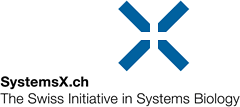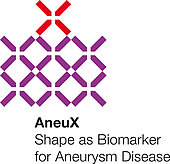AneuX
Shape as Biomarker for Aneurysm Disease
Intracranial aneurisms are weak spots on blood vessels in the brain that balloon out and fill with blood. They are mostly quiescent and asymptomatic, but potentially lethal. There is currently no tool available to help predict aneurysm development or treatment outcomes. The scientists involved in the MRD Project AneuX aim to change this by using shape as a biomarker for aneurysm diagnosis.
How blood and vessel walls interact to regulate blood flow, and how blood flow influences vessel shape, are key biological questions with high medical relevance. The precise biomechanical processes and conditions resulting in injury and disease remain obscure, but answers to these questions may provide fundamental insight into the formation, growth and progression of intracranial aneurysms. The biological reactions of the vessel wall may result in characteristic shape deformations, which are visible to modern routine imaging procedures. Thus aneurysm 3D shape can be used as a biomarker to characterize the status and severity of the condition.
Three percent affected
The MRD Project AneuX will focus entirely on intracranial aneurysms. The occurrence of the disease is high, with three percent of the population affected. Although intracranial aneurysms are mostly benign, a rupture is likely to cause severe brain damage or death, resulting in a high socio-economic impact.
An increasing number of patients are incidentally diagnosed with asymptomatic aneurysms. Most of these remain stable, but the criteria used to recommend intervention are controversial. Despite the increasing quality of imaging data, physicians still lack the adequate tools for safe decision making at the individual level.
Developing a predictive tool
The AneuX MRD Project’s starting point is the hypothesis that aneurysm 3D-shape can be used as an image biomarker. The involved partners will follow a twin-track strategy centered on shape characterization:
- The biological track will integrate the basic biological findings of mechano-biological transduction into a vessel-remodeling simulator. The simulations will be validated with an experimental animal model of growing aneurysms.
- The clinical track will collect and organize clinical evidence, using machine-learning techniques to consider shape descriptors.
Combined, these approaches will improve both the prediction of disease progression and clinical decision-making. The goal is to generate an integrated mathematical model able to predict disease trajectory and treatment outcomes, which will be validated in a subsequent clinical trial.
| Principal Investigator | PD Dr. med. Philippe Bijlenga, Neurosurgery, Department of clinical neurosciences, Geneva University Hospital |
| Involved Institutions | UniGE/HUG, ZHAW, UZH, ETHZ, UniGE, UZH/USZ |
| Number of Research Groups | 6 |
| Project Duration | Mar. 2015 – Feb. 2018 |
| Approved SystemsX.ch Funds | CHF 1.875 million |
Updated June 2015


